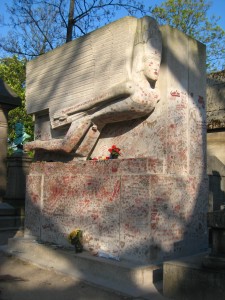 Oscar Wilde died of cerebral meningitis in Paris on November 30, 1900. On the occasion of the 110th anniversary of his death, his tomb in Paris’ famous Père Lachaise Cemetery has been restored and a new glass barrier erected around the monument to stop visitors from making out with it.
Oscar Wilde died of cerebral meningitis in Paris on November 30, 1900. On the occasion of the 110th anniversary of his death, his tomb in Paris’ famous Père Lachaise Cemetery has been restored and a new glass barrier erected around the monument to stop visitors from making out with it.
The practice began in the late 1990s when a woman kissed Wilde’s tomb leaving a red lipstick print. Because people are easily influenced and deeply unhygienic, that one lip print started an unstoppable trend. The tomb was soon covered in red lips. The threat of a €9,000 ($12,000) fine for damaging a historical monument had no effect, because it’s hard to catch people in the act and because most of the kissers were tourists and thus were long gone before the judicial system could snag them. Appeals from Wilde’s grandson Merlin Holland to stop the practice fell on deaf ears. A plaque asking fans to respect the tomb instead of defacing it had no effect.
 Meanwhile, those greasy red lipstick stains seeped into the stone making it harder and harder to clean. Every cleaning stripped another surface layer which made the stone even more porous, so the next cleaning had to go even deeper and wear away the stone even more. Today’s restoration will hopefully end this vicious cycle.
Meanwhile, those greasy red lipstick stains seeped into the stone making it harder and harder to clean. Every cleaning stripped another surface layer which made the stone even more porous, so the next cleaning had to go even deeper and wear away the stone even more. Today’s restoration will hopefully end this vicious cycle.
With the Paris authorities offering a fraction of the cost of preserving the memorial, the Irish have come to the rescue, paying for it through the office of public works in Dublin, which is responsible for a number of Irish monuments and buildings overseas. They have paid for a radical cleaning and “de-greasing” of the tomb, as well as a glass barrier which will surround it to prevent the kissers from causing further damage. […]
Holland hopes that the barrier will deter loving vandals. Designed to be unobtrusive and aesthetic, it could only discourage rather than be preventative and he says: “Some determined kissers will no doubt try to find ways of kissing the upper extremities.”
It’s fitting, perhaps, that Oscar Wilde’s memorial has experienced more than its fair share of scandal and hardship. It didn’t even exist until 14 years after Wilde’s death. He was bankrupt when he died, so his family and friends could only afford to bury him in a cheap plot in the Cimetière de Bagneux southwest of Paris. Through sales of Wilde’s writing over the next decade, Ross was able to afford a new plot in Père Lachaise. Wilde’s remains were reburied in their new, elegant Parisian digs in 1909.
Two years later, a friend of Ross and Wilde’s donated money to commission a memorial sculpture for the gravesite. Sir Jacob Epstein was the sculptor. He created a stylized Art Deco angel inspired by Assyrian winged lion and bull colossi at the British Museum. The monument was unveiled in 1914 and even the sophisticates of Paris clutched their pearls and popped their monocles. Why? Because the angel had male genitalia. The police labeled it indecent and covered it with a tarp.
In the early 1960s, the unfortunate manparts were hacked off and stolen and are still missing to this day.
Holland spoke of his mixed emotions at the monument in its restored state: “The graffiti was done with love, which is an unusual phenomenon.